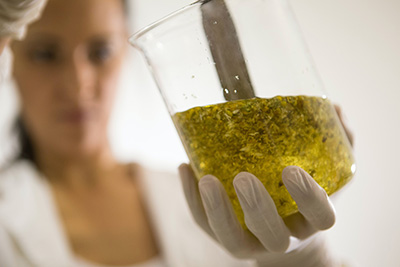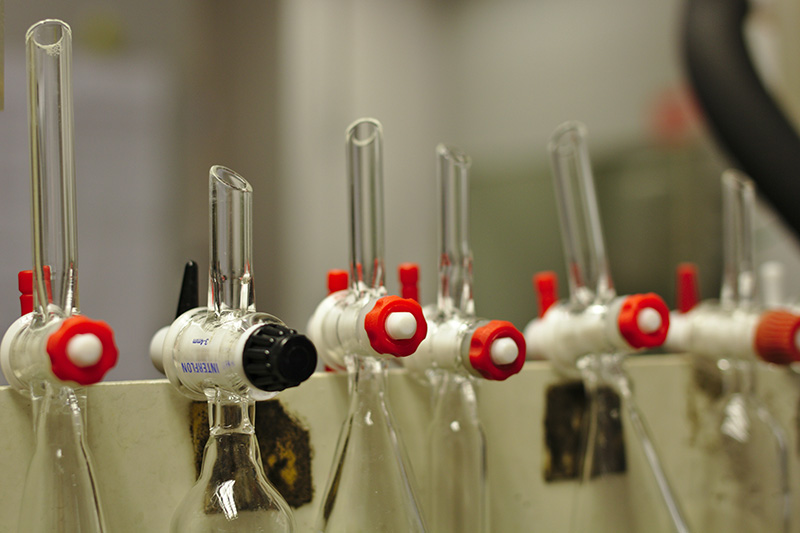There are several different types of polymer deformulation. Deformulation is the process of breaking down and identifying the individual components that make up a polymer. Many factors come into play when determining individual chemical components, morphology, and thermal interactions of polymers. This is where polymer deformulation steps in to identify multiple variables of a polymer via reverse engineering techniques.
First, let’s review some of the analytical methods available for polymer deformulation. The classes of these methods include the following:
Spectrographic Analysis
Spectrographic analysis measures and interprets colors generalized from visible light to the electromagnetic spectrum (all bands).
Chromatographic Analysis
The chromatographic analysis separates mixtures of chemical substances into individual compounds for a thorough analysis of each.
Thermal Analysis
Thermal analysis focuses on polymers’ thermophysical interactions and kinetic properties (or other materials).
Specific types of Polymer Deformulation
Polymer deformulation can be accomplished using many methods. However, it depends on the objectives and materials to determine the best technique. If you want to find a suitable technique for the deformulation of paint, here are a few methods that may come in handy.
Thermal Gravimetric Analysis (TGA)

Thermal Gravimetric Analysis (TGA) is a thermal analysis technique that determines the physical and chemical property changes in materials due to increasing temperature. This type of polymer deformulation is highly effective when determining the amounts of solvents (water), polymers (binders), and inorganics (pigments). Lab experts and polymer manufacturers use TGA to evaluate the selected characteristics of compounds with gain or loss of mass due to various factors, like oxidation, decomposition, loss of volatility, and more.
The common applications of TGA are material characterization, studies of degradation techniques and reaction kinetics, determination of organic content (in materials), and determination of inorganic content (in materials).
Fourier Transform Infrared Spectroscopy (FTIR)
Fourier Transform Infrared (FTIR) Spectroscopy is an analytical method used to identify organic, polymeric, and inorganic materials using infrared light. When conducting this technique, experts use infrared light to scan material samples to study the chemical properties of the compounds (present in the sample). FTIR is greatly used for industrial quality assurance purposes. QA teams employ this technique to evaluate industrially manufactured polymers (like paints) to declare them contamination-free.
The common applications of FTIR analysis include the identification and characterization of unknown materials (powders, liquids, films, etc.), identification of contamination in or on test material, identification of additives after extraction from a polymer matrix, and identification of oxidation, decomposition, or monomers (uncured) in investigative analysis.
X-Ray Fluorescence Spectroscopy (XRF)
X-Ray Fluorescence Spectroscopy (XRF) is a type of polymer deformulation used for non-destructive chemical analyses of materials like sediments and fluids. The XRF method relies on wavelength-dispersive spectroscopic principles, similar to EPMA. XRF is mostly used for bulk analyses of geological materials. It also helps in fingerprinting inorganic materials like calcium and titanium.
The common applications of XRF are cement production, ceramic manufacturing, glass manufacturing, metallurgy, sedimentary and metamorphic petrology, mining, and petroleum-related processes.
Nuclear Magnetic Resonance Spectroscopy (NMR)
Nuclear Magnetic Resonance Spectroscopy (NMR) is a technique used for molecular analysis by recording electromagnetic radiation’s radiofrequency (Rf) interaction with the nuclei of molecules present in a strong magnetic field. NMR is a powerful analytical strategy for organic chemists. It provides information on the molecules’ structure, the content quality, and the sample’s purity. NMR is handy when separating the compounds in a polymer, identifying the binder, and giving the copolymer’s molar ratio.
The common application of NMR is the study of investigative properties of organic materials containing nuclei possessing spin.
Gas Chromatography-Mass Spectroscopy (GC-MS)
Another type of polymer deformulation is Gas Chromatography-Mass Spectroscopy (GC-MS). This technique is used to detect and measure trace organic constituents in bulk material samples. This method separates the components of a mixture to identify them using the mass spectrometer. GC-MS is widely used for polymer deformulation. It comes in handy when determining the type of solvent(s) in a formulation.
The common applications of GC-MS include drug detection, fire investigation, environmental analysis, explosive analysis, and identification of unknown material samples.
Pyrolysis Gas Chromatography-Mass Spectroscopy (Py-GC-MS)
Pyrolysis Gas Chromatography-Mass Spectroscopy (Py-GC-MS) is a chemical analysis technique to perform qualitative and quantitative analysis of components in a sample. In this method, a sample is anaerobically introduced to a heated environment and broken into smaller fragments using controlled thermal degradation or pyrolysis. Py-GC-MS can effectively characterize various polymers and composites that cannot be evaluated with traditional techniques.
The common applications of Py-GC-MS include rapid sediment contamination assessment and characterization of involatile macromolecular complexes in materials.
Liquid Chromatography-Mass Spectroscopy (LC-MS)
Liquid Chromatography-Mass Spectroscopy (LC-MS) is an effective analytical technique for separating, identifying, and quantifying known and unknown compounds in a material. This type of polymer deformulation is also used to elucidate the molecular structure and properties of compounds in a material. LC-MS works efficiently when analyzing small molecules in multicomponent-containing substances.
LC-MS is common in multiple industries, including pharmaceuticals, forensics, food, and environmental sectors.
Gel Permeation Chromatography (GPC)
Gel Permeation Chromatography (GPC) is an analytical procedure that helps to separate dissolved supermolecules by size based on their elution from gel-filled columns. GPC differs from other techniques that rely on physical or chemical interactions for separation and uses porous beads to accomplish the goal.
The common applications of GPC are the determination of the relative molecular weight of polymers and the distribution of molecular weights.
Differential Scanning Calorimetry (Thermal) (DSC)
Differential Scanning Calorimetry (DSC) is a thermal analysis method to evaluate the properties of a sample, such as glass transition temperature, crystallization, melting, heat capacity, cure process, purity, and thermal stability. This powerful type of polymer deformulation provides test data for various materials, including plastics, polymers, laminates, composites, etc.
The common applications of DSC cover investigating polymer heating responses, melting crystalline polymers, glass transition, and more.
Dynamic Mechanical Analysis (Thermal) (DMA)
Dynamic Mechanical Analysis (DMA) is a thermal analysis technique used to study the viscoelastic behavior of polymers. Experts apply sinusoidal stress to the material and measure the strain to determine the complex modulus. DMA allows measuring the stiffness of a sample (polymer) under the influence of various factors.
DMA measures various polymer material types using tension, compression, dual cantilever bending, 3-point bending, and shear.
Reformulation: The Ultimate Test
At National Polymer, we are experts at deformulating a product down to its component parts using some or all of the types of polymer deformulation detailed above. The ultimate test, however, is reformulating a polymer based on the detailed results of a deformulation project to fully confirm that all of the individual elements in their specific amounts discovered in during the deformulation process will successfully come back together to form an identical version of original polymer. If it does not, then the deformulation process must be reviewed and executed again to fully identify the underlying elements and their quantities the compose the original polymer.
In addition to confirming the accuracy of a polymer deformulation, reformulation can also can help identify areas for improvement in the original formulation. By fully understanding the component parts of a polymer, we can help find ways to make a “new and improved” version using the reformulation process.
The Takeaway
Depending on your goals, the types of polymer deformulation methods reviewed above may be used individually or in combination in order to render a complete and accurate deformulation. When paired with reformulation, providing the formulation chemist with sufficient information (for reverse engineering) is crucial.
To learn more about National Polymer’s deformulation-reformulation (reverse engineering) expertise and services, contact us at (800) 679-0477 or email us at info@nationalpolymer.com.



